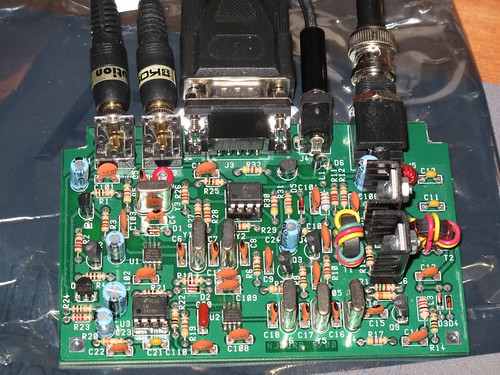Posts Tagged ‘Digital modes’
 The completed Warbler
The completed Warbler
A few weeks ago I finished the box to mount the Warbler. The connectors are all soldered directly to the pcb board so the alignment of holes had to be done carefully. When doing such layout and drilling I am always grateful of the ‘O’level in metalwork that I finished back in high school thirty years ago now. (As a sidenote I am currently reading ‘Shop Class as Soulcraft’ by Matthew Crawford which covers the recent decline of school shop classes).
The box is aluminium (showing my British origin with the spelling) and made by Hammond. To give it a nice finish I spray painted it with a couple of coats of Rustoleum Universal hammered spray paint and it came out rather well.
The box size is 4.5″×3.5″ so it makes quite a nice compact unit.
I need to look at the final output power of my Warbler as I think it is a little low, but it is performing well and I have made 80m PSK31 contacts out in Wisconsin, Illinois and North Carolina. As previously reported I have also used the Warbler for an Olivia contact. A great kit and I am looking forward to using it over the Winter when 80m conditions should be better than they are now. Unfortunately, it looks like Small Wonder Labs have dropped it from their current product line.
 First contacts with the Warbler
First contacts with the Warbler
Despite Summer not being the best time of year for 80m QSOs I have made a couple of contacts over the last two nights with the recently completed Warbler.
The first was a PSK31 contact with AE1Q who was about 285 miles away in Belgrade Lakes, Maine. The next was an Olivia 8/500 contact with VE3FMC in St Thomas, Ontario, about 325 miles away. Both QSOs proved to be tougher copy for the other stations as the Warbler puts out only about 2 Watts. However, they were successful QSOs and as can be seen by the picture above the Warbler receives well.
AE1Q gave me an IMD report which was -24 dB which is reasonable given the simplicity of the rig, but I would like it to be below -30dB.
I was fortunate and pleased that the second contact was using Olivia. This is a nice mode for QRP. For those wanting to try Olivia I recommend you read the information on the Olivia website by Gary, WB8ROL, including his QST article. Gary writes great articles (including one in the recent amateur radio edition of Linux Journal) and I have enjoyed a few Olivia QSOs with him.
Finally, if you do want to try Olivia or any multifrequency keying mode with the Warbler, you must remember that you are operating on LSB with the Warbler. Most digimode operators will be using USB so the frequencies will be reversed. The digimode software, Fldigi, offers a simple solution to this, you must select the “Rv” or ‘reverse’ button (see the lower right of the Fldigi window above, which is selected and green). You do not need to worry about this button if you just use PSK31 as it is symmetrical about a centre frequency.
 Warbler now finished and working
Warbler now finished and working
I finally finished my Small Wonder Labs Warbler kit last night. This was started probably two years ago and then was shelved for no particular reason other than I was working on other projects. Last week I decided it was time to get it finished and so have been working on it in the evenings. It is a nice kit with a clever design based around colour burst crystals and the receiver is direct conversion. It was straight forward to build but note there are two SOIC components, the SA612 mixers (look for U1 and U2 in the photo above).
When it came to the smoke test it worked first time. I adjusted the one tuning capacitor (the only adjustment), for frequency alignment and checked power out. Alignment was done as recommended with W1AW which was coming in well (see the screenshot below). On transmit, I get 2W out on my Radio Shack power meter. It is expected that you can get 3 to 4W out of the Warbler. Given the accuracy of the meter I happy with what I measured.
I have an aluminium enclosure, which is a tight fit for the board, so there is some careful drilling and filing to come. You can see in the photograph I have already cut out the corners to accommodate for the enclosure screw mounts.
Given the simplicity of the transceiver I am very pleased at how well it works. No contacts yet, so will have to see what the IMD is later. Anyone within 100 miles or so of Ottawa want to try a QSO?
















